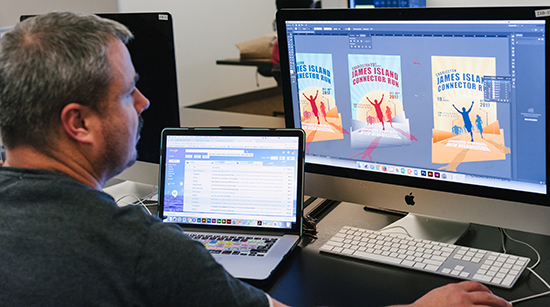
A minimal website design is one with no graphic elements or typography. Your choice of typeface is the most important aspect of minimalism. All other elements on your website should also match this design. Be mindful of your audience when making this decision. Also, be aware of the font's readability. These tips will help you answer any questions. Contact us if your website is not minimalist enough!
White is preferred for minimalist website design
A minimalist design uses a color palette that is composed of two or more font families and one color. It should emphasize imagery and primary information. Not cluttered pages. Whitespace allows the user to be focused on the content of the website and not on any distractions. This forces web designers to use color sparingly to convey the message to their readers.
White space can make a website appear cleaner and more readable. It also highlights important elements like images and calls-to-actions. The first page of a website is where most people will be looking. A white background helps users easily identify the most important aspects of the design. The best color to use for a minimalist website design is white.

Bright colors
Although bright colors can be a great choice for website design, it can backfire. Use them sparingly, and only in the most important places. They will help your visitors become more familiar with the colors and differentiate important calls-to-action. These colors will make your website more attractive and will help you to attract visitors. Find out the best examples for minimal design that use bright colors.
Contrasting colors are a great way of attracting attention. The colors in this website design work well together. The combination of a bright yellow-green and a gray background is perfect. The bright yellow attracts the eye to the title and path up the mountain as well as the call-to-action buttons. These colors will create a feeling of excitement and dynamism to your website. This design will appeal a wide audience. So use it sparingly.
Hidden navigation
Hidden navigation is a common technique for minimalist website designs. This type web design emphasizes the need for minimal navigation so that visitors can concentrate on other design elements such the call to action and scheme. This style of web design encourages conversion and improves user interaction. It saves time and allows users to quickly identify call-to action buttons.
Hidden navigation buttons or links are another common mistake in minimalism. This can be a good idea, but it can make the website less user-friendly. Users who are unfamiliar with the icons or links may get lost if they can't find the navigation elements. Hidden navigation is not a good idea. This approach is not recommended for sites with lots of content. Instead, keep navigation elements visible. It can also aid in search engine optimization.

Typography
You've likely noticed that minimalist websites have simple fonts, and often they are black. Large logos and headlines can be intimidating. Bold type and smaller fonts can make a big difference. Because typography adds an extra layer to dynamic visuals and white spaces, this is why it's so important. Each font has its unique language, personality, and role in the overall design.
Websites can be minimal and minimalist but still employ a variety colors to evoke emotion and encourage users engage with the content. Typography should not be too distracting or make it difficult for users to read. Keep your website simple and elegant while using a range colors. This will help you engage your visitors. You can use bold fonts and images to invoke an emotional response.
FAQ
What is Website Design Software?
Web design software is used to create web pages and other digital media by graphic artists, photographers and illustrators.
There are two types of website design software available: cloud-based and desktop apps. Desktop apps are installed locally on your computer and require you to install additional software on your computer. Cloud-based solutions can be hosted remotely over the internet. They are ideal for mobile users as they don't require additional software.
Desktop Applications
Desktop applications may have more advanced features than cloud-based solutions but they aren’t always necessary. Some people prefer to work exclusively from a desktop app because they find it more convenient. Some people like the same tool no matter whether they're working on a computer or a smartphone.
Cloud-Based Solutions
A cloud-based solution is a good choice for web designers who are looking to save money and time. These services let you edit any type or document anywhere you have an internet connection. This allows you to use your tablet while waiting for your coffee maker to brew.
If you decide to go with a cloud-based service, you'll still need to purchase a license for the program. You don't have to buy additional licenses for upgrading to the latest version.
These programs can be used in Photoshop, InDesign, Illustrator or any other Adobe product to create web pages.
What is a responsive design web design?
Responsive Web Design, also known as RWD, is a way of designing websites so that content displays on all devices. This includes desktop computers, tablets (tablets), smartphones, etc. This allows users to simultaneously view a website from one device while still being able to access other features, such as navigation menus and buttons. RWD is intended to ensure that any user viewing a site views the exact version on their screen.
A website that sells primarily through eCommerce would be an example of this. You want your customers to be able to purchase products from your store, even if they are viewing it on a phone.
A responsive site will automatically adjust its layout based on the device being used to view it. Your laptop will view the website exactly as a normal desktop site. The page will look completely different if it's viewed on your smartphone.
This allows you to create one website that works on all devices.
What does a UI designer do?
The interface design team for software products is called a user interface (UI). They design the application's layout and visual elements. Sometimes, the UI designer might also include graphic artists.
The UI Designer needs to be a problem solver and have a good understanding of how people use computers.
A UI Designer should have a passion in technology and software design. He/she should be familiar with all aspects in the field, from creating ideas to implementing them into code.
They should be capable of creating designs using a variety tools and techniques. They should be able to think creatively and solve problems by creating innovative solutions.
They should be detail oriented and organized. They should be able to develop prototypes quickly and efficiently.
They should be comfortable working with clients, both large and small. They must be capable and willing to adapt to new situations and environments.
They should be able and willing to communicate effectively with others. They should communicate clearly and concisely.
They must be well-rounded and have strong communication skills.
They must be driven, motivated, and highly motivated.
They should be passionate about what they do.
What types of websites should you make?
This question is dependent on your goals. Your website should be able to sell products online. This will allow you to build a successful business. This will require you to set up a strong eCommerce site.
Blogs are another popular type of website. Each of these requires different skills and tools. For example, to set up a website, you need to understand blogging platforms such WordPress or Blogger.
It is important to choose the right platform for your site. You can find many free templates and themes for every platform.
After you have chosen a platform, it is time to add content. Pages can include images, videos, text and links.
When you are ready to launch your new website, you can publish it online. Visitors can view your site online once it has been published.
Statistics
- Did you know videos can boost organic search traffic to your website by 157%? (wix.com)
- The average website user will read about 20% of the text on any given page, so it's crucial to entice them with an appropriate vibe. (websitebuilderexpert.com)
- It enables you to sell your music directly on your website and keep 100% of the profits. (wix.com)
- When choosing your website color scheme, a general rule is to limit yourself to three shades: one primary color (60% of the mix), one secondary color (30%), and one accent color (10%). (wix.com)
- It's estimated that in 2022, over 2.14 billion people will purchase goods and services online. (wix.com)
External Links
How To
How can you tell which CMS is better?
There are two types of Content Management System. Web Designers can choose between static HTML or dynamic CMS. WordPress is the most well-known CMS. Joomla! is an excellent CMS for making your site professional and well-organized. You can create any kind of website with Joomla!'s powerful open-source CMS. It is easy to set up and configure. Joomla comes with thousands upon thousands of templates and extensions, so you don’t need to hire an expert to set up your site. Joomla is available for free download. Joomla is an excellent choice for your next project.
Joomla is an excellent tool for managing all aspects of your website. Joomla offers many features, such as a drag and drop editor, multiple templates support, image manager blog management, news feed, eCommerce, and a blog management. Joomla's many features make it a great option for anyone who doesn't want to spend hours learning code.
Joomla works with almost all devices. It is easy to build websites for different platforms.
There are many good reasons to prefer Joomla over WordPress. Some of them include:
-
Joomla is Open Source Software
-
Easy to Install and Configure
-
Over 2,000 ready-made Templates and Extensions
-
Download and use it for free
-
Supports Almost All Devices
-
Powerful Features
-
A great support community
-
Very Secure
-
Flexible
-
Highly Customizable
-
Multi-Lingual
-
SEO friendly
-
Responsive
-
Social Media Integration
-
Mobile Optimized